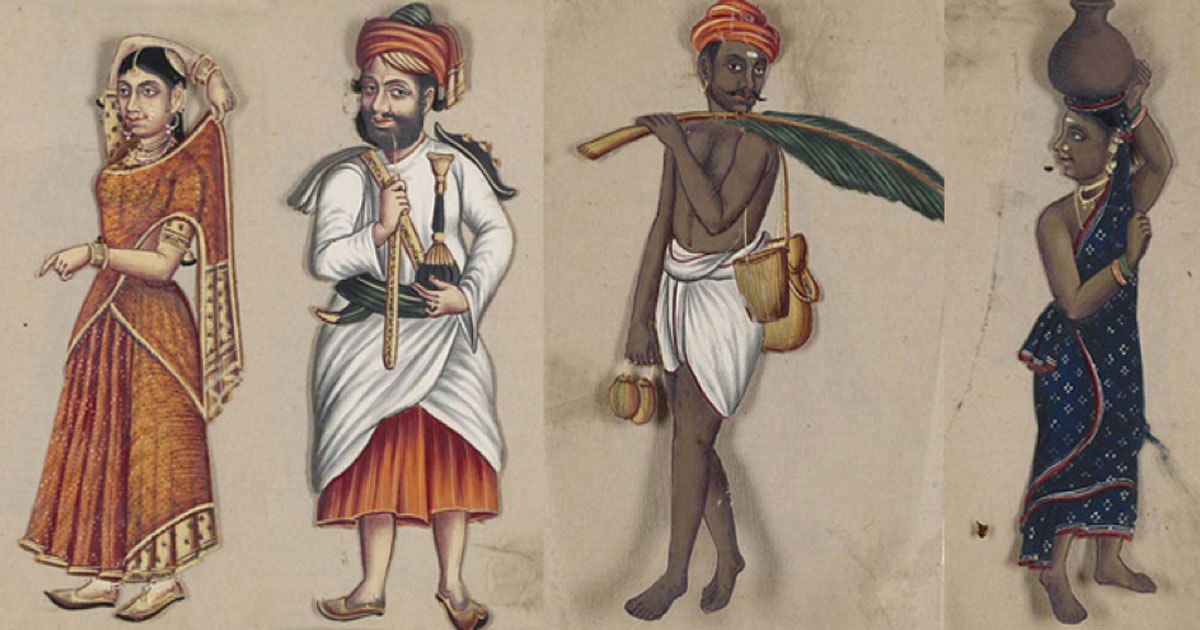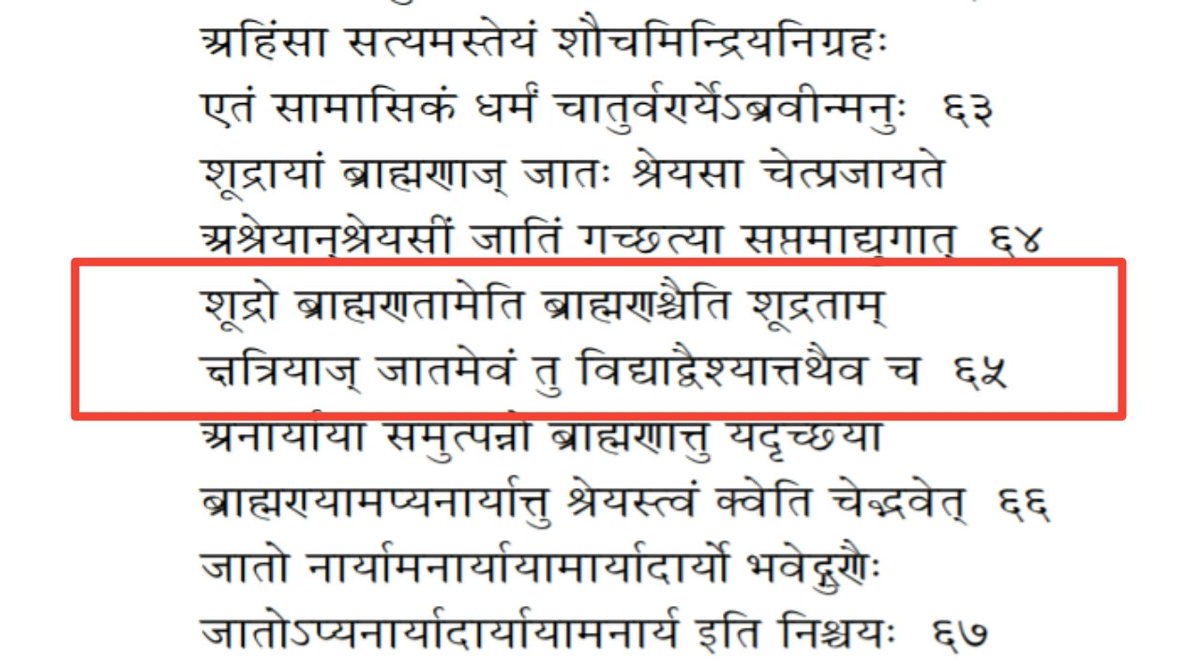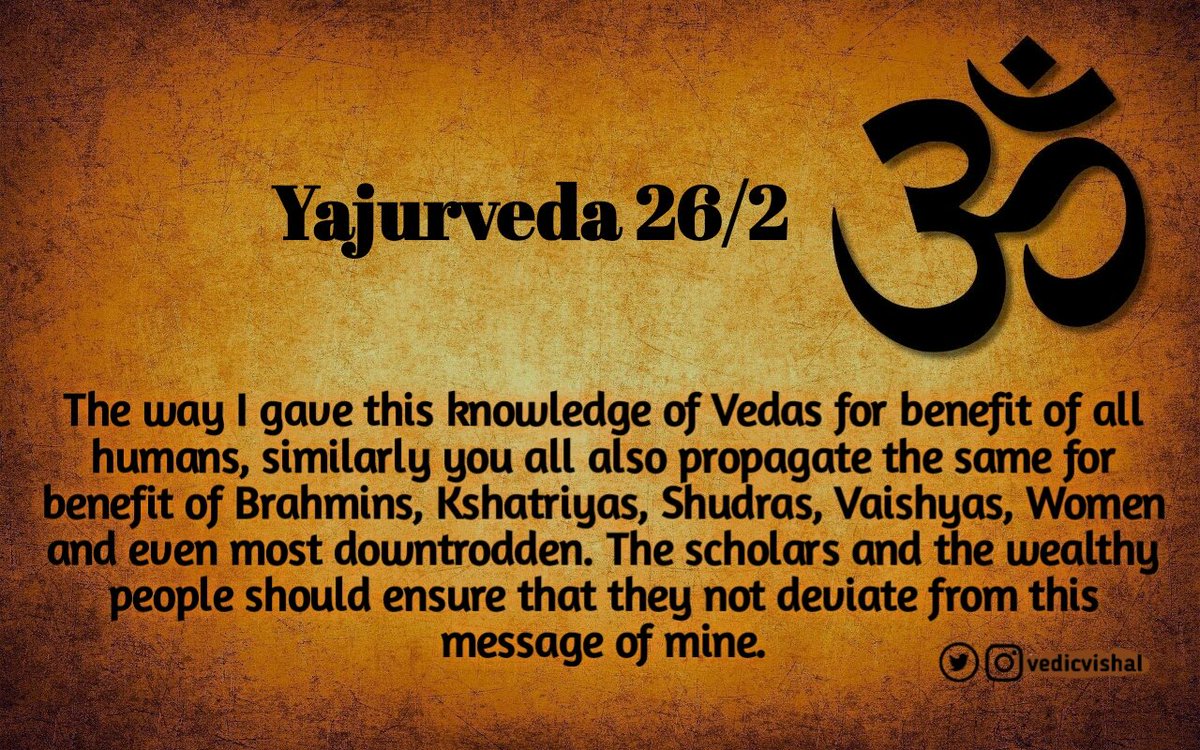Shudras and their position in Sanatan Dharma
The Shudra is a common and "virtue" based sangya in the Vedic Varna Vyavastha, one of the four varnas.
The Shudra is a common and "virtue" based sangya in the Vedic Varna Vyavastha, one of the four varnas.
Who is Shudra?
Yajurveda 35/5 says "तप॑से॒ शू॒द्रं" means श्रम, i.e. one who generates food etc. through hard work n शूद्र is the one who does hard work etc. like crafts. The word तप is used in the वेदमन्त्र for ईश्वर who creates all the things of the world with infinite power.
Yajurveda 35/5 says "तप॑से॒ शू॒द्रं" means श्रम, i.e. one who generates food etc. through hard work n शूद्र is the one who does hard work etc. like crafts. The word तप is used in the वेदमन्त्र for ईश्वर who creates all the things of the world with infinite power.
The present day Dalits cannot be included in the Shudras as per Shastra’s definition of Shudra. One word that has been used for shudra, which is very important and accurate, is 'एकजाति'(one birth). This makes the background and reality of शूद्रवर्ण clear.
What is एकजाति?
According to Manusmriti the first birth (एकजाति) is when they are born (प्राकृतिक जन्म) of their mothers' wombs. According to Manu, there is also a second birth(द्विज). The second when they receive the initiation of the गायत्री मन्त्र.
According to Manusmriti the first birth (एकजाति) is when they are born (प्राकृतिक जन्म) of their mothers' wombs. According to Manu, there is also a second birth(द्विज). The second when they receive the initiation of the गायत्री मन्त्र.
(This संस्कार in which they receive the initiation is known as the Upanayana or the यज्ञोपवीत संस्कार). This means that a बालक who goes to his विद्या at the time prescribed for receiving ज्ञान in the Vedas (with all the formal धार्मिक संस्कार performed) is born a second time.
However, a बालक who deliberately or on account of being a dullard or being incapacitated to acquire विद्या in any of the three द्विज वर्ण remain ekjati, which means the one having only one birth(एकजाति), a mere natural or शूद्र.
Besides, the man who, despite having received विद्या in anyone of the three varnas does not carry out the prescribed duties and obligations of that varna, also becomes a Shudra.
Can a Shudra become Dwija?
Once the Vedic Samskara (यज्ञोपवीत संस्कार) of the Shudra's son begin with proper Vedic rites, he gets the title of Brahmans, Kshatriyas and Vaishyas by virtue and deeds.
Once the Vedic Samskara (यज्ञोपवीत संस्कार) of the Shudra's son begin with proper Vedic rites, he gets the title of Brahmans, Kshatriyas and Vaishyas by virtue and deeds.
Maharishi Manu 10/65 says in this verse that a ब्राह्मण becomes a शूद्र and vice versa on the basis of one’s merits, actions and abilities. Similarly such an interchange also takes place between क्षत्रिय and वैश्य.
Can Shudra read Vedas?
This question itself self is wrong because everyone has right to study Vedas. Yajurveda 26/2 say —
यथे॒मां वाचं॑ कल्या॒णीमा॒वदा॑नि॒ जने॑भ्यः। ब्र॒ह्म॒रा॒ज॒न्या᳖भ्या शूद्राय॒ चार्या॑य च॒ स्वाय॒ चार॑णाय च।
This question itself self is wrong because everyone has right to study Vedas. Yajurveda 26/2 say —
यथे॒मां वाचं॑ कल्या॒णीमा॒वदा॑नि॒ जने॑भ्यः। ब्र॒ह्म॒रा॒ज॒न्या᳖भ्या शूद्राय॒ चार्या॑य च॒ स्वाय॒ चार॑णाय च।
Actually Varna of a person is decided after completing of education not on the basis of birth. यज्ञोपवीत is a संस्कार to begin वेदाध्ययन. Vedas do not prohibit education to shudra but it says to teach vedas even to a shudra.
जन्मनाजायतेशुद्र:,संस्काराद्द्विज् उच्यते।
Every person is born a Shudra. It is only on the performance of the यज्ञोपवीत संस्कार later that he becomes a द्विज. Every one attains his or her varna only after completing education.
Every person is born a Shudra. It is only on the performance of the यज्ञोपवीत संस्कार later that he becomes a द्विज. Every one attains his or her varna only after completing education.
So there is no question of reading Vedas of Shudra, because after Upanayana one can get Vaidic knowledge through Guru.
Least Punishment for Shudras
The शूद्र is the least and the all the varnas is the most liable to punishment as per maharishi manu’s मानव धर्मशास्त्र Manusmriti. (See: 8/337 | 8/338)
The शूद्र is the least and the all the varnas is the most liable to punishment as per maharishi manu’s मानव धर्मशास्त्र Manusmriti. (See: 8/337 | 8/338)
A convict in crimes like theft etc. has to be punished keeping in mind the principle that higher the varna to which he belongs the greater the punishment be meted out to him as there is expected to be greater understanding on his part in respect of the seriousness of the crime,
Its consequences and social implications. Thus a Shudra is to be punished 8 times severely, the Vaishya 16 times, a Kashatriya 32 times, Brahmana 64 times; nay, hundred times or even 128 times more severely.
Is there any discrimination against the Shudra?
Vedas do not discriminate between different classes.They consider everyone as equal. Yajurveda says that O ईश्वर make me so gentle that all Brahmans, Kshatriyas, Vaishyas and Shudras have affection for me.
Vedas do not discriminate between different classes.They consider everyone as equal. Yajurveda says that O ईश्वर make me so gentle that all Brahmans, Kshatriyas, Vaishyas and Shudras have affection for me.
Yajurveda 19•62•1 state that –
प्रियं मा कृणु देवेषु प्रियं राजसु मा कृणु।
प्रियं सर्वस्य पश्यत उत शूद्र उतार्ये॥
O Ishwara! Please make me beloved among enlightenment men, male me beloved among the princes and make me dear to everyone who sees, be he Shudra.
प्रियं मा कृणु देवेषु प्रियं राजसु मा कृणु।
प्रियं सर्वस्य पश्यत उत शूद्र उतार्ये॥
O Ishwara! Please make me beloved among enlightenment men, male me beloved among the princes and make me dear to everyone who sees, be he Shudra.
Are Dwijas Superior?
There is no one superior or inferior in the Vedas. All are equal just like brothers.All should help each other to attain the pleasures of this as well as the other world.
There is no one superior or inferior in the Vedas. All are equal just like brothers.All should help each other to attain the pleasures of this as well as the other world.
Atharvaved 19.32.8 says that – O Lord! May I be loved by everyone– Brahmin, Kshatriya, Shudra or Vaishya. May I be admired by everyone.
प्रियं मां दर्भ कृणु ब्रह्मराजन्याभ्याम्शूद्राय चार्याय च।
यस्मैं च कामयामहे सर्वस्मै च विपशयते॥
प्रियं मां दर्भ कृणु ब्रह्मराजन्याभ्याम्शूद्राय चार्याय च।
यस्मैं च कामयामहे सर्वस्मै च विपशयते॥
In the Vedic period, there were four classes in the social system called 'varna'. After taking birth in any clan, any child or person could accept the qualities, deeds and abilities of the desired varna and hold it.
It is clear from these mantras that a Vedas considers all वर्ण – Brahman, Kshatriya, Vaishya and Shudra to be equal and respects them equally.
|| कृण्वन्तो विश्वमार्यम् ||
|| कृण्वन्तो विश्वमार्यम् ||

 Read on Twitter
Read on Twitter



